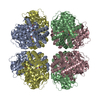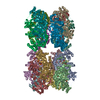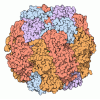[English] 日本語
 Yorodumi
Yorodumi- PDB-7qsy: Non-obligately L8S8-complex forming RubisCO derived from ancestra... -
+ Open data
Open data
- Basic information
Basic information
| Entry | Database: PDB / ID: 7qsy | ||||||
|---|---|---|---|---|---|---|---|
| Title | Non-obligately L8S8-complex forming RubisCO derived from ancestral sequence reconstruction and rational engineering in L8S8 complex | ||||||
 Components Components |
| ||||||
 Keywords Keywords | LYASE / Ribulose 1 / 5-bisphosphate carboxylase/oxydase / RubisCO | ||||||
| Function / homology | 2-CARBOXYARABINITOL-1,5-DIPHOSPHATE Function and homology information Function and homology information | ||||||
| Biological species | synthetic construct (others) | ||||||
| Method |  X-RAY DIFFRACTION / X-RAY DIFFRACTION /  SYNCHROTRON / SYNCHROTRON /  MOLECULAR REPLACEMENT / Resolution: 2.1 Å MOLECULAR REPLACEMENT / Resolution: 2.1 Å | ||||||
 Authors Authors | Zarzycki, J. / Schulz, L. / Erb, T.J. / Hochberg, G.K.A. | ||||||
| Funding support |  Germany, 1items Germany, 1items
| ||||||
 Citation Citation |  Journal: Science / Year: 2022 Journal: Science / Year: 2022Title: Evolution of increased complexity and specificity at the dawn of form I Rubiscos. Authors: Luca Schulz / Zhijun Guo / Jan Zarzycki / Wieland Steinchen / Jan M Schuller / Thomas Heimerl / Simone Prinz / Oliver Mueller-Cajar / Tobias J Erb / Georg K A Hochberg /   Abstract: The evolution of ribulose-1,5-bisphosphate carboxylase/oxygenases (Rubiscos) that discriminate strongly between their substrate carbon dioxide and the undesired side substrate dioxygen was an ...The evolution of ribulose-1,5-bisphosphate carboxylase/oxygenases (Rubiscos) that discriminate strongly between their substrate carbon dioxide and the undesired side substrate dioxygen was an important event for photosynthetic organisms adapting to an oxygenated environment. We use ancestral sequence reconstruction to recapitulate this event. We show that Rubisco increased its specificity and carboxylation efficiency through the gain of an accessory subunit before atmospheric oxygen was present. Using structural and biochemical approaches, we retrace how this subunit was gained and became essential. Our work illuminates the emergence of an adaptation to rising ambient oxygen levels, provides a template for investigating the function of interactions that have remained elusive because of their essentiality, and sheds light on the determinants of specificity in Rubisco. | ||||||
| History |
|
- Structure visualization
Structure visualization
| Structure viewer | Molecule:  Molmil Molmil Jmol/JSmol Jmol/JSmol |
|---|
- Downloads & links
Downloads & links
- Download
Download
| PDBx/mmCIF format |  7qsy.cif.gz 7qsy.cif.gz | 864.5 KB | Display |  PDBx/mmCIF format PDBx/mmCIF format |
|---|---|---|---|---|
| PDB format |  pdb7qsy.ent.gz pdb7qsy.ent.gz | 718.9 KB | Display |  PDB format PDB format |
| PDBx/mmJSON format |  7qsy.json.gz 7qsy.json.gz | Tree view |  PDBx/mmJSON format PDBx/mmJSON format | |
| Others |  Other downloads Other downloads |
-Validation report
| Summary document |  7qsy_validation.pdf.gz 7qsy_validation.pdf.gz | 2.2 MB | Display |  wwPDB validaton report wwPDB validaton report |
|---|---|---|---|---|
| Full document |  7qsy_full_validation.pdf.gz 7qsy_full_validation.pdf.gz | 2.3 MB | Display | |
| Data in XML |  7qsy_validation.xml.gz 7qsy_validation.xml.gz | 88.8 KB | Display | |
| Data in CIF |  7qsy_validation.cif.gz 7qsy_validation.cif.gz | 127.5 KB | Display | |
| Arichive directory |  https://data.pdbj.org/pub/pdb/validation_reports/qs/7qsy https://data.pdbj.org/pub/pdb/validation_reports/qs/7qsy ftp://data.pdbj.org/pub/pdb/validation_reports/qs/7qsy ftp://data.pdbj.org/pub/pdb/validation_reports/qs/7qsy | HTTPS FTP |
-Related structure data
| Related structure data |  7qsvC  7qswC  7qsxC  7qszC  7qt1C  7qviC  6uraS S: Starting model for refinement C: citing same article ( |
|---|---|
| Similar structure data | Similarity search - Function & homology  F&H Search F&H Search |
- Links
Links
- Assembly
Assembly
| Deposited unit | 
| |||||||||
|---|---|---|---|---|---|---|---|---|---|---|
| 1 | 
| |||||||||
| Unit cell |
| |||||||||
| Components on special symmetry positions |
|
- Components
Components
| #1: Protein | Mass: 51097.797 Da / Num. of mol.: 4 Source method: isolated from a genetically manipulated source Source: (gene. exp.) synthetic construct (others) Production host:  #2: Protein | Mass: 11650.987 Da / Num. of mol.: 4 Source method: isolated from a genetically manipulated source Source: (gene. exp.) synthetic construct (others) Production host:  Variant (production host): ArcticExpress (DE3) #3: Sugar | ChemComp-CAP / #4: Chemical | ChemComp-MG / #5: Water | ChemComp-HOH / | Has ligand of interest | Y | |
|---|
-Experimental details
-Experiment
| Experiment | Method:  X-RAY DIFFRACTION / Number of used crystals: 1 X-RAY DIFFRACTION / Number of used crystals: 1 |
|---|
- Sample preparation
Sample preparation
| Crystal | Density Matthews: 2.21 Å3/Da / Density % sol: 44.26 % |
|---|---|
| Crystal grow | Temperature: 288 K / Method: vapor diffusion, sitting drop / pH: 7.7 Details: Purified enzyme (5 mg/mL) in 25 mM Tricine-NaOH, 75 mM NaCl, pH 8.0 was incubated at 3% (v/v) CO2 in air and 30 degrees C for 1 h in the presence of 0.2 mM CABP and 3.2 mM MgCl2. The enzyme ...Details: Purified enzyme (5 mg/mL) in 25 mM Tricine-NaOH, 75 mM NaCl, pH 8.0 was incubated at 3% (v/v) CO2 in air and 30 degrees C for 1 h in the presence of 0.2 mM CABP and 3.2 mM MgCl2. The enzyme was then mixed in a 1:1 ratio with 0.2 M Hepes, 20 % (w/v) polyethylene glycol 4000, pH 7.7. Before flash freezing the crystals in liquid nitrogen PEG200 was added to the mother liquor as cryoprotectant to a final concentration of 40 % (w/v). |
-Data collection
| Diffraction | Mean temperature: 100 K / Serial crystal experiment: N | |||||||||||||||||||||||||||||||||||||||||||||||||||||||||||||||||||||||||||||||||||||||||||||||||||||||||||||||||||||||||
|---|---|---|---|---|---|---|---|---|---|---|---|---|---|---|---|---|---|---|---|---|---|---|---|---|---|---|---|---|---|---|---|---|---|---|---|---|---|---|---|---|---|---|---|---|---|---|---|---|---|---|---|---|---|---|---|---|---|---|---|---|---|---|---|---|---|---|---|---|---|---|---|---|---|---|---|---|---|---|---|---|---|---|---|---|---|---|---|---|---|---|---|---|---|---|---|---|---|---|---|---|---|---|---|---|---|---|---|---|---|---|---|---|---|---|---|---|---|---|---|---|---|---|
| Diffraction source | Source:  SYNCHROTRON / Site: SYNCHROTRON / Site:  ESRF ESRF  / Beamline: ID23-2 / Wavelength: 0.873128 Å / Beamline: ID23-2 / Wavelength: 0.873128 Å | |||||||||||||||||||||||||||||||||||||||||||||||||||||||||||||||||||||||||||||||||||||||||||||||||||||||||||||||||||||||||
| Detector | Type: DECTRIS PILATUS3 2M / Detector: PIXEL / Date: Jul 9, 2021 | |||||||||||||||||||||||||||||||||||||||||||||||||||||||||||||||||||||||||||||||||||||||||||||||||||||||||||||||||||||||||
| Radiation | Protocol: SINGLE WAVELENGTH / Monochromatic (M) / Laue (L): M / Scattering type: x-ray | |||||||||||||||||||||||||||||||||||||||||||||||||||||||||||||||||||||||||||||||||||||||||||||||||||||||||||||||||||||||||
| Radiation wavelength | Wavelength: 0.873128 Å / Relative weight: 1 | |||||||||||||||||||||||||||||||||||||||||||||||||||||||||||||||||||||||||||||||||||||||||||||||||||||||||||||||||||||||||
| Reflection | Resolution: 2.1→29.829 Å / Num. all: 124497 / Num. obs: 124497 / % possible obs: 98.1 % / Redundancy: 6.9 % / Rpim(I) all: 0.092 / Rrim(I) all: 0.244 / Rsym value: 0.225 / Net I/av σ(I): 3.1 / Net I/σ(I): 6.3 / Num. measured all: 856910 | |||||||||||||||||||||||||||||||||||||||||||||||||||||||||||||||||||||||||||||||||||||||||||||||||||||||||||||||||||||||||
| Reflection shell | Diffraction-ID: 1
|
- Processing
Processing
| Software |
| |||||||||||||||||||||||||||||||||||||||||||||||||||||||||||||||||||||||||||||||||||||||||||||||||||||||||
|---|---|---|---|---|---|---|---|---|---|---|---|---|---|---|---|---|---|---|---|---|---|---|---|---|---|---|---|---|---|---|---|---|---|---|---|---|---|---|---|---|---|---|---|---|---|---|---|---|---|---|---|---|---|---|---|---|---|---|---|---|---|---|---|---|---|---|---|---|---|---|---|---|---|---|---|---|---|---|---|---|---|---|---|---|---|---|---|---|---|---|---|---|---|---|---|---|---|---|---|---|---|---|---|---|---|---|
| Refinement | Method to determine structure:  MOLECULAR REPLACEMENT MOLECULAR REPLACEMENTStarting model: 6URA Resolution: 2.1→29.34 Å / SU ML: 0.2 / Cross valid method: THROUGHOUT / σ(F): 1.02 / Phase error: 19.73 / Stereochemistry target values: ML
| |||||||||||||||||||||||||||||||||||||||||||||||||||||||||||||||||||||||||||||||||||||||||||||||||||||||||
| Solvent computation | Shrinkage radii: 0.9 Å / VDW probe radii: 1.11 Å / Solvent model: FLAT BULK SOLVENT MODEL | |||||||||||||||||||||||||||||||||||||||||||||||||||||||||||||||||||||||||||||||||||||||||||||||||||||||||
| Displacement parameters | Biso max: 116.57 Å2 / Biso mean: 20.8477 Å2 / Biso min: 8.96 Å2 | |||||||||||||||||||||||||||||||||||||||||||||||||||||||||||||||||||||||||||||||||||||||||||||||||||||||||
| Refinement step | Cycle: final / Resolution: 2.1→29.34 Å
| |||||||||||||||||||||||||||||||||||||||||||||||||||||||||||||||||||||||||||||||||||||||||||||||||||||||||
| LS refinement shell | Refine-ID: X-RAY DIFFRACTION / Rfactor Rfree error: 0 / Total num. of bins used: 14
| |||||||||||||||||||||||||||||||||||||||||||||||||||||||||||||||||||||||||||||||||||||||||||||||||||||||||
| Refinement TLS params. | Method: refined / Origin x: -16.7958 Å / Origin y: -5.0775 Å / Origin z: 4.1275 Å
| |||||||||||||||||||||||||||||||||||||||||||||||||||||||||||||||||||||||||||||||||||||||||||||||||||||||||
| Refinement TLS group |
|
 Movie
Movie Controller
Controller



 PDBj
PDBj





